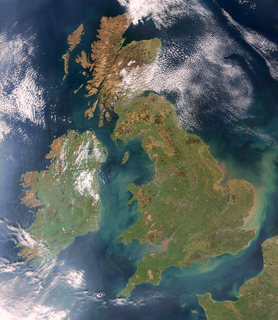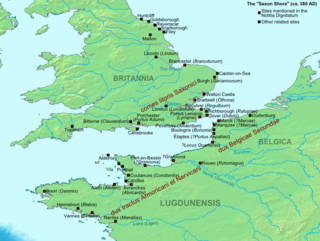
The Dumnonii or Dumnones were a British tribe who inhabited Dumnonia, the area now known as Devon and Cornwall in the further parts of the South West peninsula of Britain, from at least the Iron Age up to the early Saxon period. They were bordered to the east by the Durotriges tribe.

Rheged was one of the kingdoms of the Hen Ogledd, the Brittonic-speaking region of what is now Northern England and southern Scotland, during the post-Roman era and Early Middle Ages. It is recorded in several poetic and bardic sources, although its borders are not described in any of them. A recent archaeological discovery suggests that its stronghold was located in what is now Galloway in Scotland rather than, as was previously speculated, being in Cumbria. Rheged possibly extended into Lancashire and other parts of northern England. In some sources, Rheged is intimately associated with the king Urien Rheged and his family. Its inhabitants spoke Cumbric, a Brittonic dialect closely related to Old Welsh.

Strathclyde, was a Brittonic successor state of the Roman Empire and one of the early medieval kingdoms of the Britons, located in the region the Welsh tribes referred to as Yr Hen Ogledd, which comprised the Brythonic-speaking parts of what is now southern Scotland and northern England. The kingdom developed during Britain's post-Roman period. It is also known as Alt Clut, a Brittonic term for Dumbarton Castle, the medieval capital of the region. It may have had its origins with the Brythonic Damnonii people of Ptolemy's Geography.

Heysham is a coastal town in Lancashire, England, overlooking Morecambe Bay. It is a ferry port, with services to the Isle of Man and Ireland, and the site of two nuclear power stations.

The Carvetii were an Iron Age people and were subsequently identified as a civitas (canton) of Roman Britain living in what is now Cumbria, in North-West England.

The Brigantes were Ancient Britons who in pre-Roman times controlled the largest section of what would become Northern England. Their territory, often referred to as Brigantia, was centred in what was later known as Yorkshire. The Greek geographer Ptolemy named the Brigantes as a people in Ireland also, where they could be found around what is now Wexford, Kilkenny and Waterford, while another people named Brigantii is mentioned by Strabo as a sub-tribe of the Vindelici in the region of the Alps.

The River Ribble runs through North Yorkshire and Lancashire in Northern England. It starts close to the Ribblehead Viaduct in North Yorkshire, and is one of the few that start in the Yorkshire Dales and flow westwards towards the Irish Sea.
The Selgovae were a people of the late 2nd century AD who lived in what is now the Stewartry of Kirkcudbright and Dumfriesshire, on the southern coast of Scotland. They are mentioned briefly in Ptolemy's Geography, and there is no other historical record of them. Their cultural and ethnic affinity is commonly assumed to have been Brittonic.

Lancashire is a county of England, in the northwest of the country. The county did not exist in 1086, for the Domesday Book, and was apparently first created in 1182, making it one of the youngest of the traditional counties.

Sir John Rhys, was a Welsh scholar, fellow of the British Academy, Celticist and the first professor of Celtic at Oxford University.

Cantre'r Gwaelod, also known as Cantref Gwaelod or Cantref y Gwaelod, is a legendary ancient sunken kingdom said to have occupied a tract of fertile land lying between Ramsey Island and Bardsey Island in what is now Cardigan Bay to the west of Wales. It has been described as a "Welsh Atlantis" and has featured in folklore, literature, and song.
Morgens, morgans, or mari-morgans are Welsh and Breton water spirits that drown men.
Seithenyn sometimes known as Seithenyn of the feeble mind is a figure from Welsh legend, apparently contemporary with King Gwyddno Garanhir. He is the protagonist of a poem in the Llyfr Du Caerfyrddin. According to legend, he was responsible for the sea-defences of Cantre'r Gwaelod or Maes Gwyddno, in the kingdom of the legendary Gwyddno Garanhir, but neglected them one night because of his drunkenness. Because of this neglect, the sea overran it.

The toponym "British Isles" refers to a European archipelago consisting of Great Britain, Ireland and adjacent islands. The word "British" is also an adjective and demonym referring to the United Kingdom and more historically associated with the British Empire. For this reason, the name British Isles is avoided by some, as such usage could be misrepresented to imply continued territorial claims or political overlordship of the Republic of Ireland by the United Kingdom.

Great Britain is an island in the North Atlantic Ocean off the northwest coast of continental Europe. With an area of 209,331 km2 (80,823 sq mi), it is the largest of the British Isles, the largest European island, and the ninth-largest island in the world. The island is dominated by a maritime climate with narrow temperature differences between seasons. The 60% smaller island of Ireland is to the west – and together these islands, along with over 1,000 smaller surrounding islands and named substantial rocks, form the British Isles archipelago.

The Saxon Shore was a military command of the late Roman Empire, consisting of a series of fortifications on both sides of the Channel. It was established in the late 3rd century and was led by the "Count of the Saxon Shore". In the late 4th century, his functions were limited to Britain, while the fortifications in Gaul were established as separate commands. Several Saxon Shore forts survive in east and south-east England.

Manaw Gododdin was the narrow coastal region on the south side of the Firth of Forth, part of the Brythonic-speaking Kingdom of Gododdin in the post-Roman Era. It is notable as the homeland of Cunedda prior to his conquest of North Wales, and as the homeland of the heroic warriors in the literary epic Y Gododdin. Pressed by the Picts expanding southward and the Northumbrians expanding northward, it was permanently destroyed in the 7th century and its territory absorbed into the then-ascendant Kingdom of Northumbria.

Turkdean is a village and civil parish in Gloucestershire, England, approximately 30 km (20 mi) to the east of Gloucester. It lies in the Cotswolds, an Area of Outstanding Natural Beauty.

Brigantia is the land inhabited by the Brigantes, a British Celtic tribe which occupied the largest territory in ancient Britain. The territory of Brigantia which now forms Northern England and part of The Midlands covered the majority of the land between the River Tyne and the River Humber forming the largest Brythonic Kingdom in ancient Britain. It was recorded by Ptolemy in the 2nd century AD to extend sea to sea, from the Irish sea on the west coast to the North Sea in the east.
















